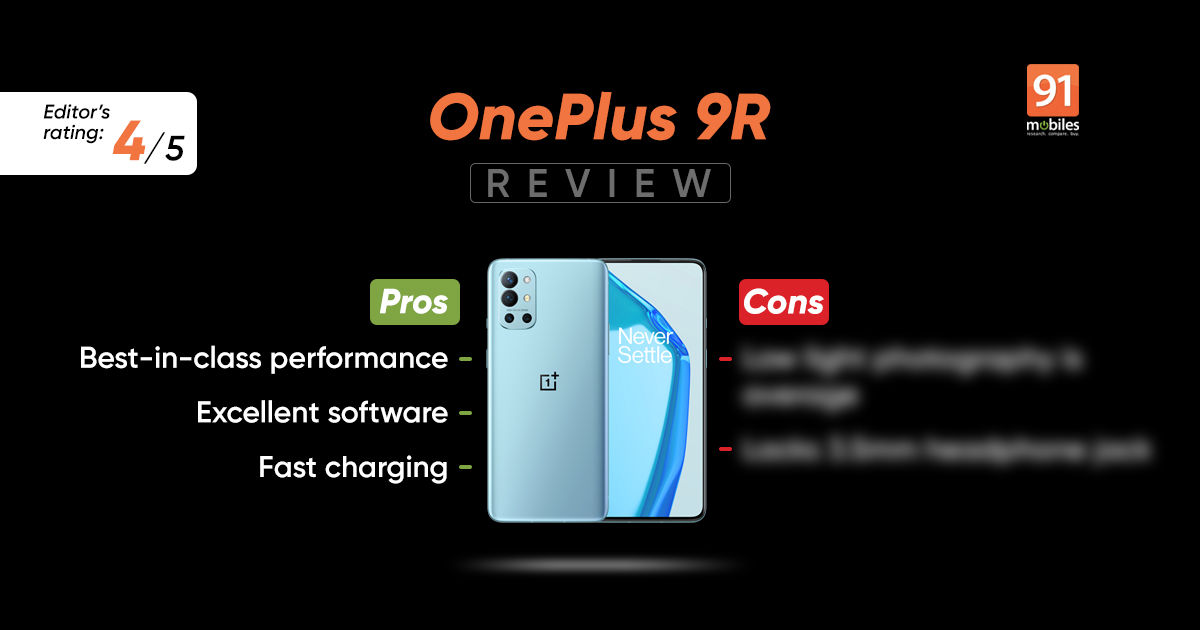It has become increasingly clear that OnePlus is looking to diversify its portfolio of products and address different price points. The affordable flagship segment around which OnePlus managed to amass a cult following looked vacant this year from the brand’s standpoint. Both the OnePlus 9 and 9 Pro come across as premium flagships, and the OnePlus of old, which was among the first to match breakthrough hardware with affordable prices seems missing in action. Enter the OnePlus 9R, the third phone in the company’s OnePlus 9 series lineup. The OnePlus 9R looks to set the precedent for future affordable OnePlus phones. Now obviously when I say affordable, I mean from the standpoint of current flagship phones. Priced at Rs 39,999, the OnePlus 9R has some big shoes to fill, especially with the likes of the Galaxy S20 FE 5G (review) and the Vivo X60 hovering around the same price point. Let’s dive in deep with this detailed review of the OnePlus 9R to see what makes it click.
Table of Contents
Verdict
The OnePlus 9R is a fair proposition in terms of the phone’s pricing. For Rs 39,999, you get great performance, along with a very fluid and clean software experience. The photography, especially in low light, might not be spectacular, but it’s still pretty good. Fast charging, decent battery life, and an attractive design contribute to the OnePlus 9R being a great purchase decision.
Design and display
The OnePlus 9R follows similar design choices seen on its two siblings, sans the very prominent Hasselblad branding. In fact, you won’t find the word Hasselblad written on any part of the OnePlus 9R’s box which makes it clear that the Swedish camera maker did not play a part in ‘co-developing’ the 9R’s cameras. Even so, putting aside the optics of the device, the 9R is nearly identical to the OnePlus 9 (review) as far as design is considered. If I were to pull out some differences, I’d say that the back on the 9R is slightly more glossy than the 9. It does employ the same 3D Corning Gorilla Glass which curves smoothly into the polished metal frame. The antenna lines along with the signature alert slider, and the power and volume rocker buttons are positioned exactly in the same spots as well. There is a negligible difference in the weight of both the 9 and 9R, although I did feel the latter to be a teensy bit heavier in my hand. Camera positioning is spot on for both the devices and the 9R has an extra lens on the bottom part of the housing as well as an additional LED flash. The stereo speaker setup has become a staple on OnePlus phones and you will find the USB-C and dual-SIM slot in the usual place. The OnePlus 9R feels premium to the touch, and has the looks with two nice colour variants, and to go along with that, the phone feels extremely durable too.
On the front, the story is pretty much identical to the OnePlus 9. You get a 6.55-inch AMOLED panel with a resolution of 2,400 x 1,080 (FHD+), a 20:9 aspect ratio, and a 120Hz refresh rate. The minuscule punch-hole for housing the selfie shooter is in the same position at the top left and the panel is flat with slim bezels on all the sides. In fact, the screens on both phones even have the same brightness levels at 1,100 nits, along with HDR10+ certification, 8192 levels of automatic brightness adjustments, 240Hz touch sampling rate, excellent viewing angles, and extensive display tuning capabilities. If you put the OnePlus 9 and 9R side-by-side face-up, you won’t really be able to tell which is which. I certainly couldn’t. The verdict for the 9R’s display is basically the same as that of the OnePlus 9: easily the best viewing experience for its price. It is an area that OnePlus seldom fails and to get the OnePlus 9’s display capabilities on a device costing Rs 10,000 lower is definitely a big plus in my books.
Cameras
The Hasselblad partnership for the OnePlus 9 and 9 Pro cameras grabbed quite a few headlines. Even if I ever to keep that aside for a moment, I think the OnePlus 9 employs excellent sensors in its triple-camera set up which made a significant difference in the camera results. The OnePlus 9R offers a quad-camera layout with the trusty 48MP Sony IMX586 sensor, seen in several phones over the past two years, as its primary lens. It is supported by a 16MP Sony IMX481 ultra-wide sensor with a 123-degree field of view, a 5MP macro shooter, and a 2MP monochrome camera. If this feels familiar, then you would be right since this exactly what the OnePlus 8T offered as its optics. Needless to say that the 9R’s image capturing is quite good, at least for its price. Details, dynamic range, and colours, for the most part, are on point. A slightly brighter sun can dampen saturation levels or overexpose the subject, but it happens on very rare occasions. The OnePlus 8T did see some orange tinting in shots when my colleague had reviewed it, but there are no traces of that happening on the OnePlus 9R. HDR and Smart Scene recognition plays an important role in fine-tuning details in post-processing.
Focusing speeds are fast as are the shutter speeds and clicking fast-moving objects was not a problem. To say the least, I’m was generally impressed with the 9R’s daylight shooting. The ultra-wide lens does not have the same level of correction of warping around the edges as on the 9 and 9 Pro’s, but it still gets in a decent amount of detail. The focus does remain a bit soft around the centre but it is very evenly spread out across the frame. The macro shooter is actually not that great and I’ve mostly avoided using it. Lastly, the monochrome sensor on the OnePlus 9R doesn’t seem very useful. One thing I did notice was the inclusion of OIS on the OnePlus 9R, a feature that is noticeably absent on the OnePlus 9. This did help in keeping shots sharp and correct for shake, although the difference is not immediately noticeable.
In low-light, the OnePlus 9R has the tendency to overexpose shots and there is a decent amount of lens flaring as well in an indoor, dimly lit scenario. Shadows were not particularly prominent and detailing was sparse without adequate lighting. The manual exposure control does however work well to reduce noise, but it comes at the cost of dull colours. The Nightscape mode uses fine-tuned computational photography to add exposure but the excessive oversharpening to remove noise does give the shot a very soft look. I would term the OnePlus 9R as an above-average low-light shooter which clicks reasonable photos but always with scope for improvement. Finally, the 16MP selfie camera on the front is the same old Sony IMX471 that has been part of the OnePlus family for the last three years. Selfies are good with a slight amount of oversharpening, skin tones that match, a good portrait blur, and halfway acceptable low-light shots.
Performance, gaming, and software
The OnePlus 9R comes with the Qualcomm Snapdragon 870 chipset which is somewhat of a successor to last year’s Snapdragon 865. However, the top SoC in the Android world as of now is the Snapdragon 888 that is made using the latest 5nm fabrication. I did get to test the Snapdragon 870 on the X60 Pro and you can read about how that went in this detailed performance and gaming comparison piece. For the OnePlus 9R, benchmarks do paint a very rosy picture about the device’s capabilities, showing that it is, in fact, flagship-grade and for a price of Rs 39,999, you are not going to get faster performance as things stand right now. On Antutu the OnePlus 9R has a score of 620,777 and Geekbench 5 spit out single-core and multi-core scores of 966 and 3,065. What you will notice is that the OnePlus 8T also has benchmarking scores along the same ballpark.
OnePlus does place a fair bit of emphasis on the OnePlus 9R’s gaming capabilities. However, gaming on the phone is about the same as any other OnePlus flagship phone before it. I mean there are no ‘gamer-centric’ features the phone has which weren’t already there in previous devices by the company. A couple of capacitive shoulder buttons like the one present on the iQOO 3 (review) would’ve been a nice touch… but that might be too much to ask for. 240Hz touch sampling is a good number but something to the tune of 360Hz could have better served the purpose of gaming. A headphone jack would really be the cherry on top as gamers, even casual ones like myself, do prefer a zero-latency wired audio solution. That being said, the OnePlus 9R does have a few tricks up its sleeves with the 14 temperature sensors that regulate the heating of the back panel during intensive gaming. This, combined with a graphite and copper-lined vapor chamber is supposed to keep the OnePlus 9R running cool under sustained load and heavy GPU usage. Personally, I didn’t find a huge difference between the thermals on the OnePlus 9R and last year’s OnePlus 8T.
The rest of the phone is as fast you’d expect from a high-end OnePlus device. UFS 3.1 storage (128GB or 256GB) and LPDDR5 RAM (8GB or 12GB) are vital as well for the fluidity you get on the OnePlus 9R. Haptics, a highly underrated feature, are excellent on the device and very much on par with Galaxy S21 (review) or the iPhone 12 (review). Everything from opening apps to browsing Chrome to surfing OTT platforms happens at a lightning-fast speed. That the OnePlus 9R is perhaps the fastest phone in its price range is simply stating the obvious and not fanboy pandering. Dolby Atmos support for the stereo speakers is music to the ears and the fingerprint along with face recognition is as speedy as it gets. The phone is 5G-ready, which is good news for customers desperate to get their hands on the fifth-generation technology standard for broadband cellular networks.
On the subject of software, the OnePlus 9R runs OxygenOS 11 based on Android 11. While the UI has lost some of its clean aesthetic over the years, it still remains one of the most user-friendly skins. The integration of the Google Feed and OnePlus Feed side-by-side can get a bit confusing at first, but you do get used to the gestures to summon either one after a while. A small change on the gaming front is that the FNATIC mode from before has been replaced by Pro Gaming Mode, but the functionality essentially remains the same.
Battery
In terms of power backup, the OnePlus 9R features a 4,500mAh battery that supports 65W Warp charging just like its older siblings. The 9R’s Snapdragon 870 chipset happens to be less power efficient than the Snapdragon 888 found on the 9 and 9 Pro due to a smaller fabrication process on the latter. However, in real life, differences are quite negligible. I got about 6-7 hours of screen-on time which I consider to be reasonably good for any phone. Being able to eke out a full day’s worth of usage on a single charge is possible, unless you are into heavy-duty gaming or any other GPU-intensive task. There is no wireless charging support but the super-fast 65W charging easily makes up for it. The phone goes from 0-100 percent in about 30 minutes as it charges two 2,250mAh batteries simultaneously.
Final verdict
The OnePlus 9R is able to deliver on most aspects. For Rs 39,990, there are very few phones that can bring in a clean software experience, fast flagship-grade performance, respectable cameras, and an overall polished design. There is no denying that the OnePlus 9R provides a wholesome experience, in that the user will not feel the need for additional features. You get what you pay for. I think that currently, only the Vivo X60 can trade blows with the OnePlus 9R as a competitive affordable flagship. Both phones have near-identical displays and pack in about the same battery, while being powered by the same Snapdragon 870 chipset. The X60 has, hands down, the better design with its extremely sleek looks and light in-hand feel. One could also argue that the phone also has better cameras thanks to the Zeiss partnership although the jury is still out on that. The OnePlus 9R on the other hand, definitely wins big on software and one needs to acknowledge the fact that the brand is very regular with its updates. The Warp Charge 65 is an added bonus as compared to X60’s 33W charging solution. For users preferring clean software, stereo speakers, and having their device juiced up in less than 30 minutes, the OnePlus 9R is the way to go.
Editor’s rating: 4 / 5
Pros
- Best-in-class performance
- Excellent software
- Fast charging
Cons
- Low light photography is average
- Lacks 3.5mm headphone jack




